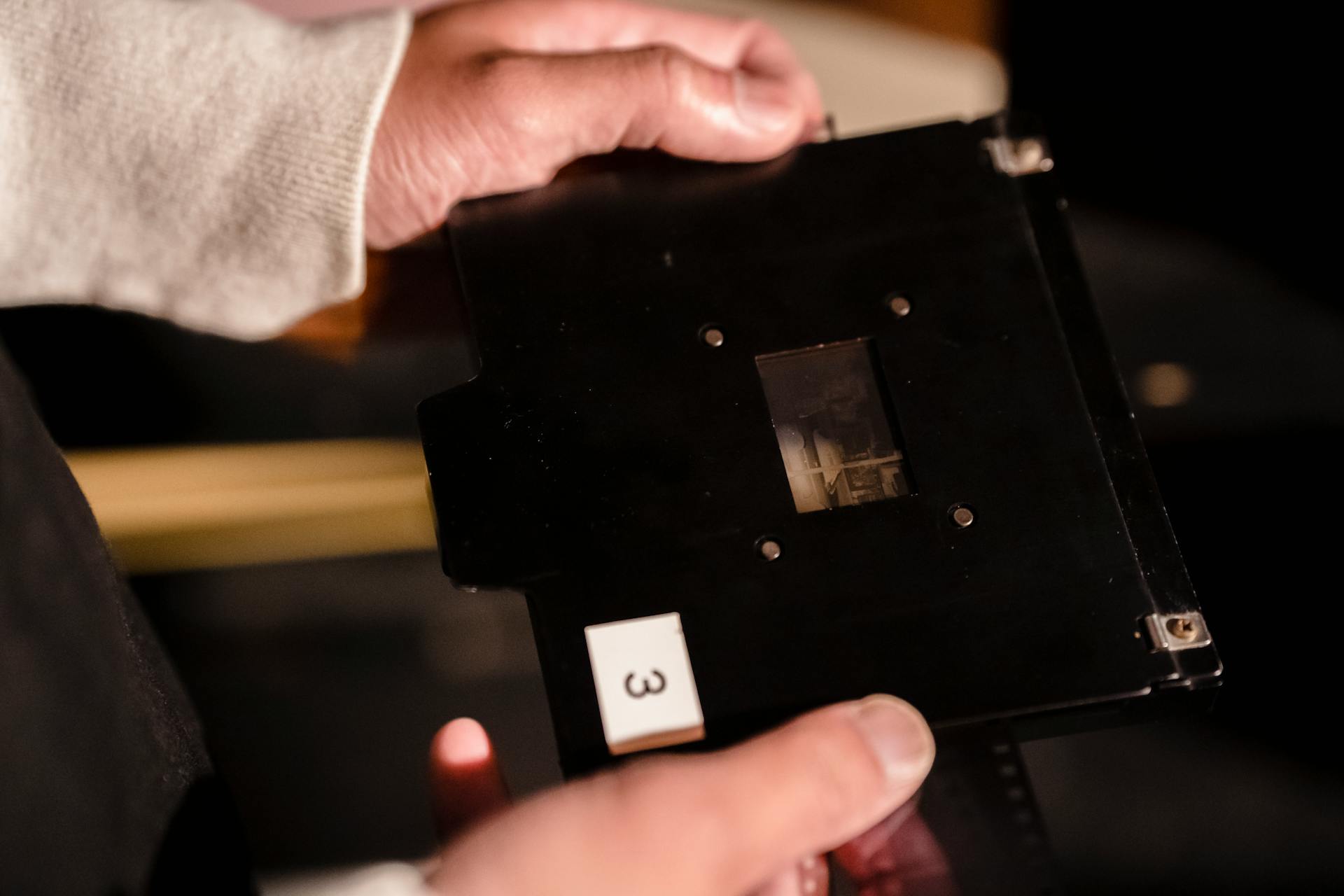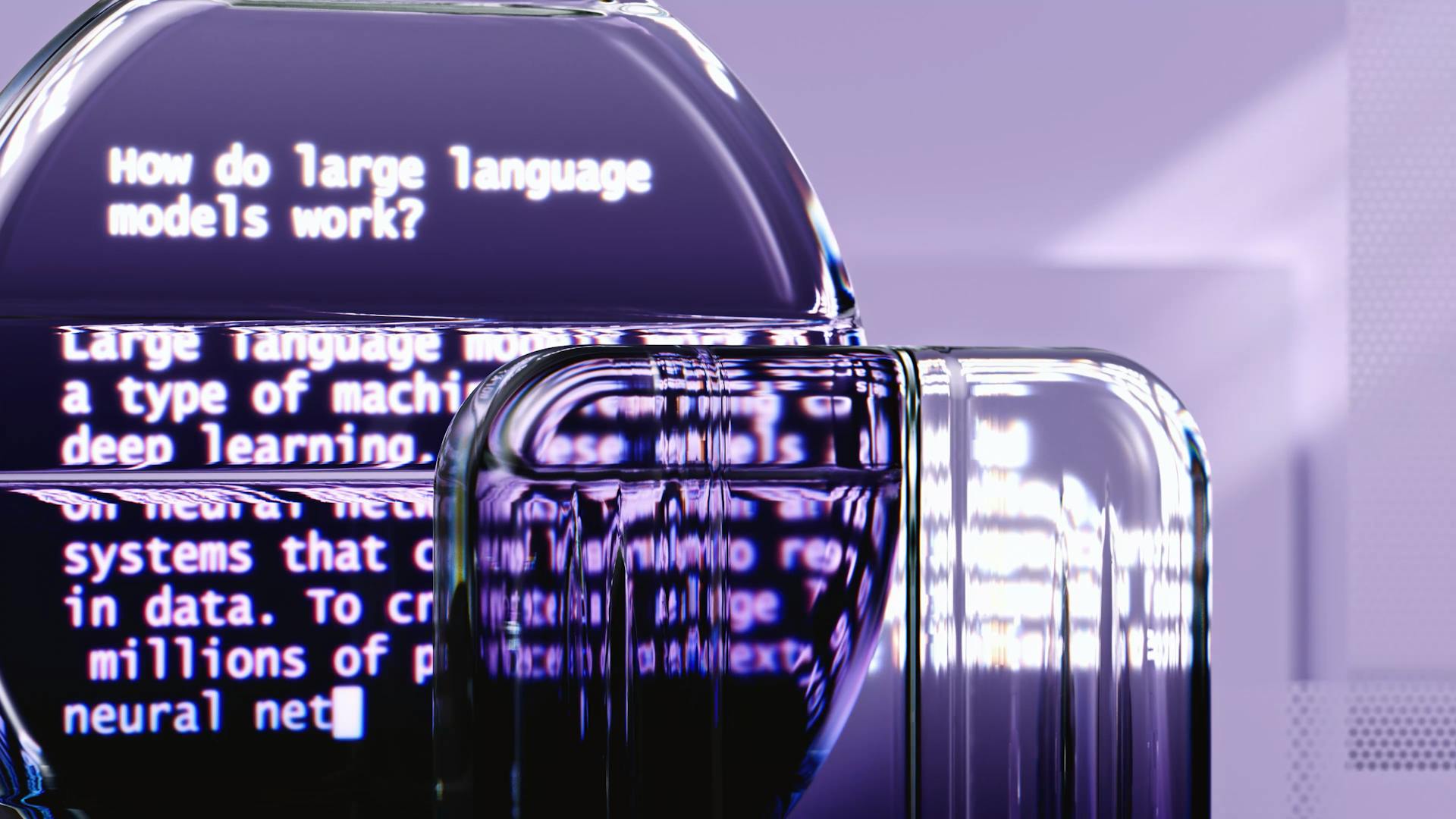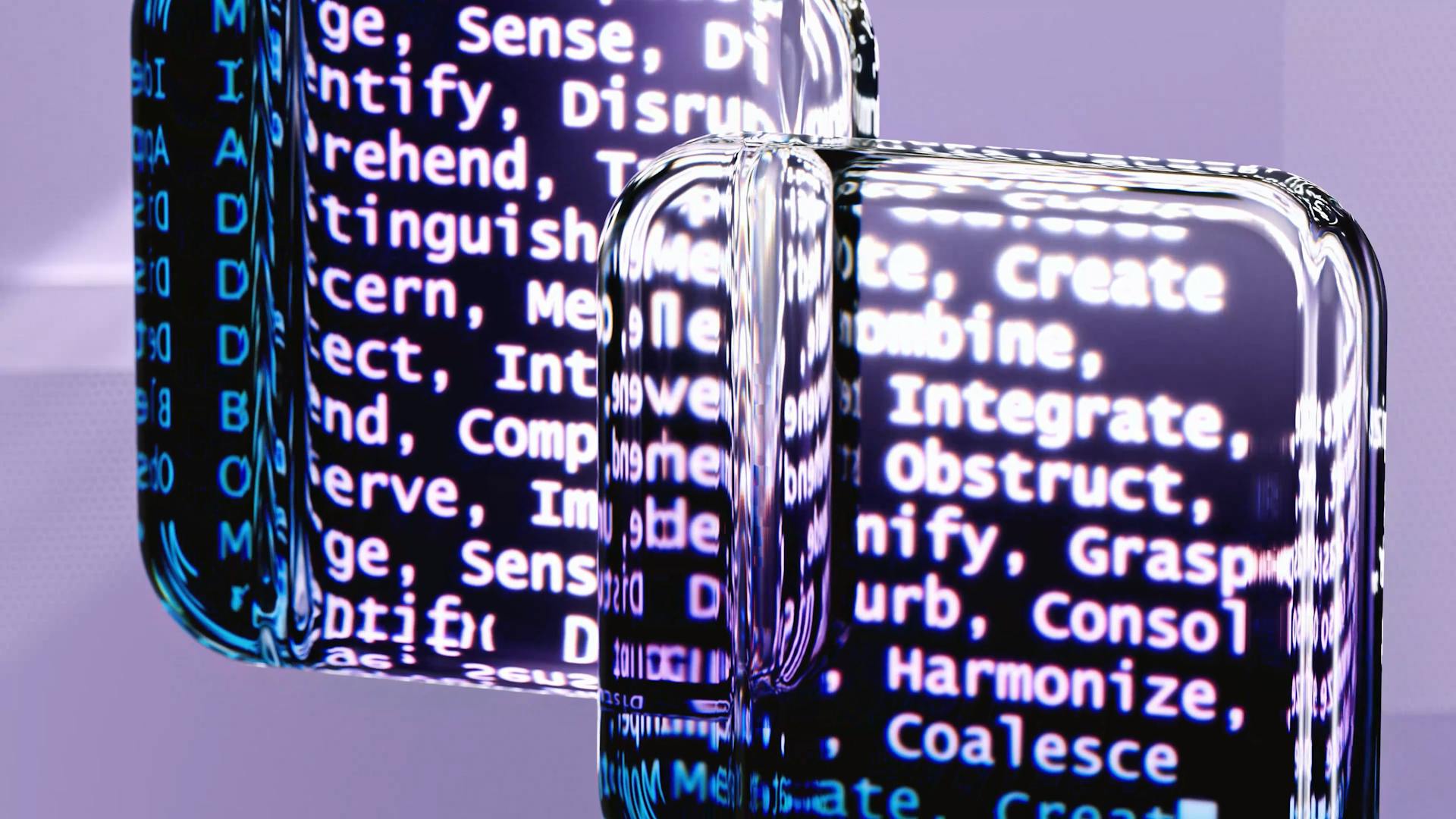
Data augmentations are a game-changer in machine learning, allowing models to learn from a limited dataset and generalize well to new, unseen data. This technique involves artificially increasing the size and diversity of a dataset by applying various transformations.
By applying these transformations, models can learn to recognize patterns and features that are not easily captured by a small dataset. For instance, rotating an image by 90 degrees can help a model learn to recognize objects from different angles.
A key benefit of data augmentations is that they can be used to reduce overfitting, which occurs when a model is too specialized to the training data and fails to generalize well to new data. By introducing random variations, data augmentations can help a model become more robust and less prone to overfitting.
Data augmentations can be applied to various types of data, including images, audio, and text. For example, adding background noise to an audio clip can help a model learn to recognize speech patterns in noisy environments.
Suggestion: Learning to Rank
Data Augmentation Techniques
Data augmentation techniques can be broadly categorized into geometric transformations, color space transformations, and noise injection. Geometric transformations, such as flipping, rotation, and cropping, can help overcome positional biases in training data. These transformations are easily implemented and can be applied to various image processing libraries.
Some common geometric transformations include image scaling, rotation, translation, shearing, and flipping. Image scaling resizes input images using scale factors, while image rotation involves rotating images at a certain angle to create additional training data. Image translation shifts images along the x and y axes, creating more training data and enhancing model strength to positional variations.
Geometric transformations have their limitations, however. For instance, certain transformations like inverting may not be ideal for certain image types, such as digits, where confusion between 6 and 9 can arise. Additionally, some transformations can result in label-changing transformations, which can be challenging to construct refined labels for.
Expand your knowledge: Geometric Feature Learning
Here are some common geometric transformations:
- Image scaling: resizes input images using scale factors
- Image rotation: rotates images at a certain angle to create additional training data
- Image translation: shifts images along the x and y axes, creating more training data and enhancing model strength to positional variations
- Image shearing: skews images along the x and y axes based on their coordinates
- Image flipping: reverses images' left and right sides
Noise injection, on the other hand, involves adding random disturbances to the pixel values of text, image, or audio signals. This technique can help introduce variability and enhance model generalization across various data types.
Noise Injection
Noise injection is a technique that involves adding random values to data, typically drawn from a Gaussian distribution. This can help models learn more robust features.
Noise injection has been tested on various datasets, including nine from the UCI repository. Adding noise to images can be particularly useful for CNNs.
Random noise injection involves adding random disturbances to pixel values in text, image, or audio signals. This can introduce variability and enhance model generalization across different data types.
Random noise injection can also help decrease overfitting and regularize data by emulating real-world noise. It's a powerful tool for improving model performance.
Here are some benefits of random noise injection:
- Suitable for introducing variability and enhancing model generalization across various data types, including image, text, and audio data.
- Effective for decreasing overfitting, emulating real-world noise in data, and regularizing it.
Geometric vs Photometric Transformations
Geometric transformations are a fundamental aspect of data augmentation, and they play a crucial role in enhancing the robustness of deep learning models. These transformations involve changing the spatial arrangement of pixels in an image, such as rotating, flipping, or scaling.
The effectiveness of geometric transformations can be seen in the work of Taylor and Nitschke, who conducted a comparative study on the effectiveness of geometric and photometric transformations. They tested these augmentations with 4-fold cross-validation on the Caltech101 dataset, which consists of 8421 images of size 256 × 256.
Geometric transformations can be categorized into several types, including image scaling, rotation, translation, shearing, and flipping. Image scaling resizes input images using scale factors, which can improve model performance and robustness to input size variations. Image rotation involves rotating images at a certain angle to create additional training data.
Here are some common geometric transformations used in data augmentation:
- Image scaling: resizes input images using scale factors
- Image rotation: rotates images at a certain angle
- Image translation: shifts images along the x and y axes
- Image shearing: skews images along the x and y axes based on their coordinates
- Image flipping: reverses images' left and right sides
These transformations can be particularly useful in tasks such as handwritten gesture recognition, where horizontal flipping is often used. However, certain transformations like inverting may not be ideal for certain image types, such as digits, where confusion between 6 and 9 can arise.
Data Augmentation Techniques" would best fit under the subheading "Meta
Data augmentation is a powerful technique for improving the performance and robustness of machine learning models. It involves artificially increasing the size and diversity of a dataset by applying various transformations to the existing data.
One of the key benefits of data augmentation is that it can help overcome the challenges of limited or imbalanced datasets. By generating new data points that are similar to the original data, data scientists can ensure that their models are more robust and generalize better to unseen data.
Generative AI models, such as Generative Adversarial Networks (GANs) and Variational Autoencoders (VAEs), have shown great promise in generating high-quality synthetic data. These models learn the underlying distribution of the input data and can generate new samples that closely resemble the original data points.
Data augmentation can be applied to various domains, including computer vision, natural language processing, and time series analysis. In computer vision, data augmentation can be used to enhance image datasets by generating new images with different transformations, such as rotations, translations, and scaling.
A fresh viewpoint: Machine Learning for Computer Security
Some common data augmentation techniques include:
Custom augmentation strategies can also be developed to meet specific demands or overcome obstacles in data extraction operations. This involves examining the dataset's unique features and limitations to find areas where standard augmentation methods may fall short, creating unique augmentation functions or transformations based on the objectives of the extraction process and the data domain, and validating them through experimentation and performance review.
For your interest: Generative Ai Data Augmentation
CutMix - MixUp
CutMix and MixUp are special transforms that are meant to be used on batches rather than individual images, as they combine pairs of images together. These can be used after the dataloader or part of a collation function.
CutMix and MixUp are variations of the MixUp augmentation technique, which forms new examples by meshing existing examples together, sometimes blending the labels as well. MixUp may take half of one text sequence and concatenate it with half of another sequence in the dataset to form a new example.
The MixUp technique can be implemented at different levels, such as word and sentence levels. Guo et al. [50] tested MixUp at word and sentence levels, finding a significant improvement in reducing overfitting compared to no regularization or using dropout.
Here are the key differences between word-level and sentence-level MixUp:
CutMix and MixUp are effective for introducing variability and enhancing model generalization across various data types, including image, text, and audio data. They can also help decrease overfitting, emulating real-world noise in data, and regularizing it.
Deep Learning and Generative Models
Synthetic data generation is a key technique in data augmentation, allowing us to produce artificial data samples using simulations or algorithms. This is particularly useful when real-world data is limited or insufficient.
Data augmentation with generative AI can be applied to various domains, including computer vision, natural language processing, time series analysis, and medical imaging. By generating new images, text samples, or time series data, we can improve the performance of machine learning models and reduce overfitting.
Data augmentation with generative AI can be used to enhance image datasets by generating new images with different transformations, such as rotations, translations, and scaling. This can help improve the performance of image classification, object detection, and segmentation models.
Here are some examples of data augmentation with generative AI:
- Computer Vision: Generating new images with rotations, translations, and scaling.
- Natural Language Processing: Generating new text samples by modifying existing sentences, such as replacing words with synonyms, changing word order, or adding noise.
- Time Series Analysis: Creating synthetic time series data by modeling the underlying patterns and generating new sequences with similar characteristics.
- Medical Imaging: Generating synthetic medical images, such as X-rays or MRI scans, to increase the size of training datasets and improve the performance of diagnostic models.
Deep
Deep learning models can benefit from data augmentation techniques to improve their robustness and generalization. Data augmentation helps expose models to various training instances, making them more resilient to real-world variations.
By applying data augmentation, models can achieve better generalization and reduce overfitting. This is because augmented data provides a wider range of training cases, allowing the model to learn more robust features.
Data augmentation can be applied to various domains, including computer vision, natural language processing, and time series analysis. In computer vision, data augmentation can involve generating new images with different transformations, such as rotations, translations, and scaling.
In natural language processing, data augmentation can involve generating new text samples by modifying existing sentences, such as replacing words with synonyms or changing word order. This can help improve the performance of text classification, sentiment analysis, and machine translation models.
See what others are reading: Computer Science Machine Learning
Data augmentation can also be used to create synthetic data, which is particularly useful when real-world data is limited or insufficient. Synthetic data can be generated using simulations or algorithms, and it can be used to improve or produce a variety of data sets for training.
Here are some examples of data augmentation techniques:
- Data augmentation with generative AI
- Synthetic data generation
- Neural augmentation
- Augmentation controllers
These techniques can be used to improve model training for various applications, including speech recognition, object detection, OCR, and sentiment analysis.
Causality and Counterfactuals
In Deep Learning, learning causal representations is crucial to achieving its goals, as opposed to solely representing correlations.
Causal Inference demonstrates how to use interventions to establish causality, and Reinforcement Learning is the most similar branch of Deep Learning research in which an agent deliberately samples interventions to learn about its environment.
Many Text Data Augmentations utilize the terminology of Counterfactual Examples, which describe augmentations such as the introduction of negations or numeric alterations to flip the label of the example.
The construction of counterfactuals in language generally relies on human expertise, rather than algorithmic construction, although the model can still establish causal links between semantic concepts and labels by observing the result of interventions.
Liu et al. laid the groundwork for formal causal language in Data Augmentation, using structured causal models and the procedure of abduction, action, and prediction to generate counterfactual examples.
Their counterfactual augmentation improved an English to French translation system from 26.0 to 28.92 according to the BLEU metric, and phrasal alignment between sequences in neural machine translation was used to sample counterfactual replacements.
DINO generates natural language inference data by seeding the generation with phrases like “mean the same thing” or “are on completely different topics”, but rigorous causal modeling may provide benefits over prompts and large language models.
Image Design and Preprocessing
Image design and preprocessing play a crucial role in data augmentations. By applying various transformations, you can encode invariances that present challenges to image recognition tasks.
Color transformations are an essential part of image preprocessing. For instance, you can randomly change the brightness, contrast, saturation, and hue of an image or video using the `v2.ColorJitter([brightness, contrast, ...])` function.
The following table summarizes some common color transformations:
Image resolution is another important aspect of image design and preprocessing. Higher resolution images require more processing and memory to train deep CNNs, but downsampling can cause information loss, making image recognition more difficult.
Image Design Considerations
Image Design Considerations involve thinking about how to effectively utilize image data augmentation techniques. Image data augmentation is a powerful tool that can improve the performance of machine learning models by increasing the size and diversity of the training dataset.
When it comes to image data augmentation, one key consideration is the type of transformation to apply. Geometric transformations, such as flipping, rotation, and cropping, can be very effective for certain tasks, but may not be suitable for others. For example, image rotation may not be ideal for tasks that require precise spatial information.
Image scaling can improve model performance and robustness to input size variations. Image scaling resizes input images using scale factors. Techniques such as image scaling, rotation, translation, shearing, and flipping are commonly employed. However, certain transformations like inverting may not be ideal for certain image types, such as digits, where confusion between 6 and 9 can arise.
Here are some common geometric transformations used in image data augmentation:
Photometric transformations, such as color jittering and edge enhancement, can also be effective for certain tasks. For example, color jittering can be used to randomize the color of images, which can help improve model robustness to changes in lighting conditions.
In addition to these transformations, other design considerations include the choice of color space and the use of kernel filters. For example, converting images to grayscale can be useful for tasks that require texture information, while using kernel filters can help improve model performance by reducing noise and artifacts.
Final Size
The final dataset size is a crucial consideration in Data Augmentation. It can change from N to 2N if all images are horizontally flipped and added to the dataset.
Transforming data on the fly during training can save memory, but will result in slower training. This approach is known as online augmentation. On the other hand, offline augmentation involves editing and storing data on the disk.
Transforming data beforehand and storing it in memory can be problematic, especially when dealing with big data. This is because storing augmented datasets in memory can be extremely memory-intensive.
In a massively distributed training system, augmenting images before training can speed up image serving. By pre-caching training batches, the system can request and augment images in advance.
Augmentations can also be built into the computational graph used to construct Deep Learning models, facilitating fast differentiation. This process occurs immediately after the input image tensor.
Exploring a subset of the inflated data that results in higher or similar performance to the entire training set is an interesting concept. This idea is related to curriculum learning and finding an optimal ordering of training data.
Here's an interesting read: Random Shuffle Dataset Python Huggingface
Composition
Composition is where the magic happens in image design and preprocessing. It's the process of combining multiple transformations to achieve the desired outcome.
To compose several transforms together, you can use the v2.Compose function. This function takes a list of transformations as an argument and applies them in the order they are listed.
You can also use v2.RandomApply to apply randomly a list of transformations with a given probability. This is useful when you want to introduce some randomness into your transformations.
Another useful function is v2.RandomChoice, which applies a single transformation randomly picked from a list. This can help you avoid over-relying on a single transformation.
Finally, v2.RandomOrder applies a list of transformations in a random order, which can be useful when you want to introduce some variability into your transformations.
Here's a summary of the composition functions:
Supported Input Types
Most transformations accept both PIL images and tensor inputs, making it easy to work with different types of data.
Both CPU and CUDA tensors are supported, giving you flexibility in terms of computational resources.
In general, we recommend relying on the tensor backend for performance, as the results from both backends (PIL or Tensors) should be very close.
Tensor images are expected to be of shape (C,H,W), where C is the number of channels, and H and W refer to height and width.
Most transforms support batched tensor input, which is a tensor of shape (N,C,H,W), where N is a number of images in the batch.
The v2 transforms generally accept an arbitrary number of leading dimensions (...,C,H,W) and can handle batched images or batched videos.
Explore further: What Is a Tensor in Machine Learning
Dtype and Value Range
Tensor images have an implicit expected range of values based on their data type. For float dtypes, this range is 0 to 1.
Images with an integer dtype are expected to have values within the range of 0 to the maximum value that can be represented by that dtype.
Typically, images of dtype torch.uint8 are expected to have values in the range of 0 to 255.
To ensure consistency in your image preprocessing, it's essential to convert both the dtype and range of your inputs using the ToDtype function.
ML Model Robustness
Data augmentation is a powerful technique for improving the robustness of machine learning models. By exposing models to various training instances, data augmentation helps improve machine learning models' resilience.
Data augmentation can reduce the effects of data variability and scarcity, improving data extraction procedures' accuracy. It achieves this by offering a more prominent and representative dataset, which allows models to benefit from a wider range of examples.
Data augmentation can also introduce diversity into the training data, reducing the probability of overfitting by exposing the model to various examples. This is especially important in cases where poor generalization on unseen data results from overfitting.
Here are some key benefits of data augmentation for improving ML model robustness:
- Data augmentation improves machine learning models' resilience by exposing them to various training instances.
- Data augmentation reduces the effects of data variability and scarcity, improving data extraction procedures' accuracy.
- Data augmentation introduces diversity into the training data, reducing the probability of overfitting.
By incorporating data augmentation into your machine learning pipeline, you can create more robust models that are better equipped to handle real-world data.
Implementation and Integration
Implementing data augmentation in data extraction processes is a straightforward process that requires a few easy techniques for optimal benefits and smooth implementation.
To integrate data augmentation into machine learning pipelines, you need to determine which ML pipeline data preprocessing stage allows for the application of augmentation. This is crucial for maintaining workflow efficiency.
Here are the key steps to integrate data augmentation into machine learning pipelines:
- Determine which ML pipeline data preprocessing stage allows for the application of augmentation.
- Before feeding the data into the model, you can use augmentation techniques for the data transformation process.
- Maintaining workflow efficiency requires compatibility with existing pipeline frameworks and libraries.
Augmentation libraries provide pre-built functions and tools to facilitate the application of augmentation techniques to various data types, making the process easier.
Extraction Process Implementation
Implementing data augmentation in data extraction processes can be a straightforward task with the right techniques.
To integrate data augmentation into current data extraction operations, determine which machine learning pipeline data preprocessing stage allows for the application of augmentation. Before feeding the data into the model, you can use augmentation techniques for the data transformation process. Maintaining workflow efficiency requires compatibility with existing pipeline frameworks and libraries.
Augmentation libraries provide pre-built functions and tools to facilitate the application of augmentation techniques to various data types. TensorFlow data augmentation API provides numerous image augmentation features in TensorFlow processes. imgaug is a versatile library for picture augmentation that allows for color space modifications, geometric changes, and other features.
Suggestion: Transfer Learning Tensorflow
To maximize efficiency, give priority to augmentation strategies that provide a good balance between computational cost and efficiency. You can use parallel processing techniques to expedite the augmentation process by using multi-core CPUs or GPUs. Employ hardware acceleration using libraries designed for GPU acceleration or specialized devices like TPUs.
Data augmentation can boost model training speed and efficiency by giving a bigger and more diverse dataset, reducing overfitting, and enhancing generalization. As a result, data extraction models become more reliable and accurate. Data augmentation lowers the expenses related to labor-intensive manual data collecting and annotation. Through augmentation, one can create artificial data samples and lessen the need for expensive or time-consuming data-collecting procedures.
Choosing Between V1 and V2
You should use the torchvision.transforms.v2 transforms instead of the v1 ones, as they're faster and can do more things.
The main advantages of v2 transforms include support for tasks beyond image classification, such as detection, segmentation, and video classification. They also support more transforms like CutMix and MixUp.
Additional reading: Binary Categorization

The v2 transforms are fully backward compatible with the v1 ones, so you only need to update the import to torchvision.transforms.v2.
Here are the key differences between v1 and v2 transforms:
In terms of output, there might be negligible differences due to implementation differences.
Challenges and Limitations
Data augmentation with generative AI is not without its challenges. The quality of generated data depends on the performance of the generative model.
Poorly trained models can produce low-quality or unrealistic data points that can negatively impact the performance of downstream models. This can be a major issue if you're relying on the generated data to improve your machine learning model's performance.
Training generative models can be computationally expensive and time-consuming. This may not be feasible for all applications, especially those with limited resources.
Here are the main challenges and limitations of data augmentation with generative AI:
- Quality of generated data
- Computational resources
- Ethical considerations
Generating synthetic data may raise ethical concerns, such as privacy and data ownership, especially when dealing with sensitive information.
Text Data Augmentation
Text Data Augmentation is a strategy to prevent overfitting via regularization, enabled through an intuitive interface. This regularization is achieved by injecting priors into our datasets.
We can inject these priors into our datasets through various mechanisms, such as back-translation, which involves translating text from one language to another and then back to the original language. This process leverages semantic invariances encoded in supervised translation datasets to produce semantic invariances for the sake of augmentation.
Back-translation has been used to train unsupervised translation models by enforcing consistency on the back-translations, and it's also been used to train machine translation models with a large set of monolingual data and a limited set of paired translation data.
Text
Text data augmentation is a powerful technique to prevent overfitting and improve the performance of natural language processing (NLP) models. It involves injecting additional data into the training process to help the model generalize better.
One way to achieve this is through back-translation augmentation, which involves translating text from one language to another and then back to the original language. This can be done with large labeled datasets of parallel sentences, such as translations between languages like English and French.
For example, taking 1,000 IMDB movie reviews in English and translating them to French and back, or Chinese and back, can help the model learn semantic invariances that are not biased by any one domain or distribution. This can be particularly useful for question answering tasks, where curating the input data and learning regime to encourage representations that are not biased by any one domain or distribution is crucial.
However, the quality of the back-translation model used can impact the final performance of the NLP model. As Pham et al. pointed out, better translation quality of the pseudo-parallel data does not necessarily lead to a better final translation model, while lower-quality but diverse data often yields stronger results instead.
Text data augmentation can also be applied to other tasks, such as text classification, paraphrase identification, and abstractive summarization. However, the design decisions for each task can vary, and the input length of the text data can impact the choice of augmentations. For example, when augmenting the context in a question answering dataset, it's essential to be mindful of removing the answer.
Discover more: Tunet and Domain Adaptation
Tokenization
Tokenization is a crucial step in the preprocessing pipeline, but it can pose a challenge for implementing Data Augmentations.
Tokenization involves converting word tokens to their numeric index in a vocabulary-embedding lookup table offline, which can be done before it reaches the Data Loader itself.
Applying Data Augmentations on these index lists requires significantly more engineering effort, even for simple tasks like synonym replacement.
Researchers are exploring tokenizer-free models, such as byT5 and CANINE, which process byte-level sequences like ASCII codes.
These models will require special processing to integrate Data Augmentations, making it a complex task.
Frequently Asked Questions
What is the difference between synthetic data and data augmentation?
Synthetic data is created from scratch, whereas data augmentation uses existing training data to generate new examples, increasing diversity and size. This subtle difference affects how each method is used in machine learning and data science applications.
What is data augmentation in CNN?
Data augmentation is a technique used in CNNs to artificially increase the size of a training dataset by applying transformations to existing images, improving model performance in image processing tasks. This technique enhances the robustness and accuracy of convolutional neural networks by exposing them to diverse variations of the same image.
What is the difference between data augmentation and data enrichment?
Data augmentation transforms existing data through manipulations like scaling and flipping, while data enrichment adds new information from external sources, cleaned and validated for accuracy. Understanding the difference between these two techniques is crucial for optimizing your machine learning model's performance.
Sources
- https://journalofbigdata.springeropen.com/articles/10.1186/s40537-019-0197-0
- https://www.docsumo.com/blogs/data-extraction/data-augmentation
- https://journalofbigdata.springeropen.com/articles/10.1186/s40537-021-00492-0
- https://pytorch.org/vision/main/transforms.html
- https://saturncloud.io/glossary/data-augmentation-with-generative-ai/
Featured Images: pexels.com


